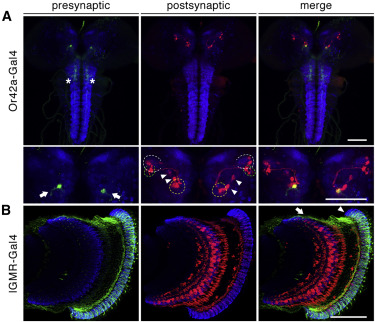Our official English website, www.x-mol.net, welcomes your feedback! (Note: you will need to create a separate account there.)
Transsynaptic Mapping of Second-Order Taste Neurons in Flies by trans-Tango.
Neuron ( IF 16.2 ) Pub Date : 2017-Nov-15 , DOI: 10.1016/j.neuron.2017.10.011 Mustafa Talay , Ethan B. Richman , Nathaniel J. Snell , Griffin G. Hartmann , John D. Fisher , Altar Sorkaç , Juan F. Santoyo , Cambria Chou-Freed , Nived Nair , Mark Johnson , John R. Szymanski , Gilad Barnea
Neuron ( IF 16.2 ) Pub Date : 2017-Nov-15 , DOI: 10.1016/j.neuron.2017.10.011 Mustafa Talay , Ethan B. Richman , Nathaniel J. Snell , Griffin G. Hartmann , John D. Fisher , Altar Sorkaç , Juan F. Santoyo , Cambria Chou-Freed , Nived Nair , Mark Johnson , John R. Szymanski , Gilad Barnea

|
Mapping neural circuits across defined synapses is essential for understanding brain function. Here we describe trans-Tango, a technique for anterograde transsynaptic circuit tracing and manipulation. At the core of trans-Tango is a synthetic signaling pathway that is introduced into all neurons in the animal. This pathway converts receptor activation at the cell surface into reporter expression through site-specific proteolysis. Specific labeling is achieved by presenting a tethered ligand at the synapses of genetically defined neurons, thereby activating the pathway in their postsynaptic partners and providing genetic access to these neurons. We first validated trans-Tango in the Drosophila olfactory system and then implemented it in the gustatory system, where projections beyond the first-order receptor neurons are not fully characterized. We identified putative second-order neurons within the sweet circuit that include projection neurons targeting known neuromodulation centers in the brain. These experiments establish trans-Tango as a flexible platform for transsynaptic circuit analysis.
中文翻译:

Trans-Tango对果蝇中的二阶味觉神经元进行突触映射。
跨定义的突触映射神经回路对于理解脑功能至关重要。在这里,我们描述了Trans-Tango,一种顺行的突触电路追踪和操纵技术。反式探戈的核心是一条合成的信号通路,该通路被引入动物的所有神经元中。该途径通过位点特异性蛋白水解将细胞表面的受体活化转化为报告基因表达。通过在遗传定义的神经元的突触处呈现束缚配体,从而激活其突触后伴侣中的途径并提供对这些神经元的遗传途径,可以实现特异性标记。我们首先在果蝇嗅觉系统中验证了反式-Tango,然后在味觉系统中对其进行了实施,在味觉系统中,一阶受体神经元以外的投射没有得到充分表征。我们在甜蜜回路中确定了推定的二阶神经元,其中包括靶向大脑中已知神经调节中心的投射神经元。这些实验将trans-Tango确立为进行突触电路分析的灵活平台。
更新日期:2017-10-27
中文翻译:

Trans-Tango对果蝇中的二阶味觉神经元进行突触映射。
跨定义的突触映射神经回路对于理解脑功能至关重要。在这里,我们描述了Trans-Tango,一种顺行的突触电路追踪和操纵技术。反式探戈的核心是一条合成的信号通路,该通路被引入动物的所有神经元中。该途径通过位点特异性蛋白水解将细胞表面的受体活化转化为报告基因表达。通过在遗传定义的神经元的突触处呈现束缚配体,从而激活其突触后伴侣中的途径并提供对这些神经元的遗传途径,可以实现特异性标记。我们首先在果蝇嗅觉系统中验证了反式-Tango,然后在味觉系统中对其进行了实施,在味觉系统中,一阶受体神经元以外的投射没有得到充分表征。我们在甜蜜回路中确定了推定的二阶神经元,其中包括靶向大脑中已知神经调节中心的投射神经元。这些实验将trans-Tango确立为进行突触电路分析的灵活平台。



























 京公网安备 11010802027423号
京公网安备 11010802027423号